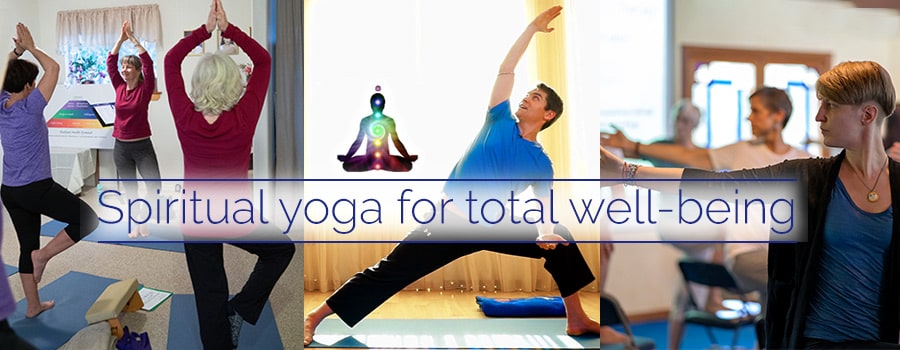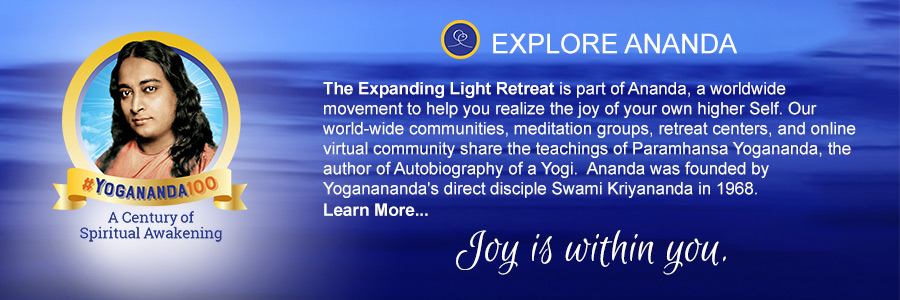“I am free! I am free!” — Yeah, right.
|
This article was written for the Ananda Yoga® Teacher Association newsletter. Learn more, or find a certified Ananda Yoga® teacher near you. |
Have you ever found yourself in an asana, beginning the affirmation, when suddenly the loudest voice in your head was not the affirmation, but an objection: “Who are you kidding? You don’t feel that way. C’mon, get real!”
Yeah, me too. The classic example is Utkatasana’s affirmation: “My body is no burden. It is light as air.” No doubt there have been times when your inner dissenter piped up: “Yes it is! And no it isn’t!” How deep can you go when that’s happening?!
Recently, I was asked about this by someone who loves to practice affirmation — in or out of asanas. They have been invaluable to her overall health, but she lamented that sometimes disbelief throws a wrench in the works. “What,” she asked, “can I do about it?”

Utkatasana, the Chair pose
Of course, this can happen with all affirmations (not just asana affirmations), as well as with chanting, mantra, prayer, meditation, and positive thinking generally. Fortunately, there are some things we can do, and because all these techniques are highly personal practices, different approaches work best for different people. Let’s look at a few approaches from the perspective of affirmations.
Full Speed Ahead!
One approach is simply to do the affirmation anyway, with all the belief and energy you can muster, hoping that, on some level of your being, mere repetition of the affirmation will do some good.
In fact, that’s not a bad idea. As you’ve no doubt observed, repetition of any words — beneficial or not — over a long period of time tends to affect your thoughts, actions, and self-image. I recall a friend who one day suddenly realized that, for a long time, she’d often been responding to questions by saying: “I don’t know. I really don’t know.” And she realized that, voilá: she had become quite unclear in her thinking and hesitant in her behavior.
It can work in the same way with affirmation, except positively. Even if you don’t believe the affirmation, the very repetition can begin to drum it into your subconscious mind. Eventually, your subconscious will begin to feed back to your conscious mind at least part of the affirmation rather than its opposite.
This approach works for some people, most notably those who tend to be optimistic and/or have developed a lot of self-discipline. The down side, however, is threefold. First, it’s a “sledgehammer approach,” and many of us are not drawn to that sort of thing. It can feel like we’re going against our own inclinations, which can make us rebel against our own efforts to change. Not good.
Second, the results of affirmation come from, not just the words we’re repeating, but our underlying attitude. If that attitude runs strongly counter to the words — e.g., “I don’t believe this!” — then what we’re driving deeper and deeper into our subconscious habit structure may be, not the affirmation, but our disbelief in it. Again, not good.
Finally, this approach ignores the fact that the true power of affirmation comes, not merely from its effect on the subconscious mind (beneficial though that is), but from the fact that it can help us tune into the superconscious, the one source of all lasting change. Mere repetition cannot take us to superconsciousness; that requires a more sensitive, refined, and dynamic effort. To put it another way, we can’t sledgehammer our way to God!
Build Up Your Bank Account
Many of us, therefore, need to find a different approach to “affirmation disbelief.” I decided to ask around. A wise man once said: “When in doubt, ask your wife.” (An even wiser man probably said, “Even when not in doubt, ask your wife.”) So I asked Diksha, who has long worked very effectively with affirmations.
“I’ve never considered a question like that” she replied immediately. “I don’t even ask myself whether I believe the affirmation. I just do it.”
Seeing the surprise on my face, she explained: “For the first four years I lived at Ananda Village, I used the affirmations in the book Affirmations for Self-Healing exactly as Swami Kriyananda suggests: one affirmation all week, each week. I didn’t try to understand them, or ask whether I believed them. I just did them, over and over. And they changed me. I began to feel the power in them, and I wanted to attune myself to that power.”
“It wasn’t a mental thing,” she continued, “analyzing the affirmations and deciding whether I believed them. It was a spiritual thing: feeling God’s power behind them, tuning into it, and trusting it, even if I was affirming something that I hadn’t yet realized in my life. That trust, that faith, still carries me today. I know from my own experience that that power can help me in any situation, so it’s not about believing or not believing a specific affirmation. If it’s a higher truth, then it’s true whether my mind believes it or not. It’s as though I built up a spiritual bank account, a trust account, and I use it to keep going even when my mind isn’t quite ready for the affirmation.”
How does she choose an affirmation? “I think about what I need, not what I believe. If my heart feels a certain need right now, then I choose an affirmation from Yogananda or Swami for that need, and I go with it. I trust the power, even if there’s no outward evidence of the truth of the affirmation. I draw upon my ‘bank account’ to make it work.” Does this always work?
“Usually, but not always,” she said. “During one period of time, I didn’t want to use any affirmation because my energy was low, my attitude toward life wasn’t positive, and my old pool of affirmations wasn’t helping me change that. I didn’t feel capable of affirming anything. Life looked bleak. I knew I had to do something to pick myself up, so I chose a chant that I thought might help: ‘O God Beautiful.’
“I chanted it a lot, and it was okay, but not much happened. Then for some reason, I had the idea to try the Bengali version of the chant (“Hey Hare Sundara”). I chanted just the first two sentences, over and over like a mantra. My energy changed immediately, so I started doing it on a regular basis. Within a week there was a great shift. My joy level was rising again, and I felt great.”
How does she explain that? “Again, it wasn’t about believing or not believing,” she said. “It was just about tuning into an energy that would lift me out of the place I was in. I realized that sometimes when you’re stuck, it might be from thinking too much, which can block you. So you might want to use an affirmation or mantra or chant from a different language to get you out of that mental rut. After all, we can’t think our way to God.
“By taking you beyond thinking, that other-language chant or affirmation can more easily take you into another vibration, where there’s nothing but the vibration itself. The more you can tune into that vibration, the more the vibration can help you change.”
Get a Larger Perspective
I next queried Anandi Cornell, a senior minister and teacher at The Expanding Light, and another affirmation aficionado. Her response was just as quick as Diksha’s, but altogether different: “You don’t believe the affirmation? Then choose another one! Why on earth would you try to affirm something you don’t believe?”
Does that mean that we should just give up? “Not at all,” said Anandi. “Instead find something you can believe — body, mind, and soul — something that touches your heart, something that lifts your whole outlook toward God rather than leaving it at the level of your rational mind.”
When I asked how she does that, she said, “When something’s not working, it’s usually because we’re too close to ourselves, too close to our fear, our hurt, our sense of lack. When we’re too involved in ourselves, we’re living small, in the ego. The solution is to get bigger, more impersonal, so I look for an affirmation that gives me some distance from my problem so I can get a better perspective.
“For example, if I’m really worried about something, my worrying blocks the flow of energy that could solve the problem. Maybe I don’t know how to solve it, but God does, and in the last analysis, it’s His problem anyway, isn’t it? My real problem is to get out of the way and let God handle it. So rather than trying to affirm that the problem isn’t even there, or that I know how to handle it — when in fact it is there and I don’t know what to do — I hand it over to Him.
“I especially like this one from Yogananada (Praecepta Lessons, 1934):
“‘I relax and cast aside all mental burdens, allowing God to express through Me His Perfect Peace, Love, and Wisdom.’
“I immerse myself in the feeling that it’s just about getting myself out of the way so God can come in. It’s very freeing, and what’s more, it’s the beginning of the solution.”
“Do you ever feel like you’re faking it?” I asked. “Can you really feel that God is doing something about the problem?”
“It’s not about trying to convince myself of something, or argue myself out of something else,” she replied. “And worrying about whether it’s working certainly isn’t helpful. Rather, the idea is to get in alignment with something higher, more powerful, more positive. If we can just align ourselves that way, that ‘something higher’ can lift us out of the space we’re in. If you do this enough, you see that it works, and you begin to trust it — then it gets much easier.”
“It’s like the story of Yogananda asking Swami one day, ‘How are you?’ Swami wasn’t feeling well at all, and hesitated, then began, ‘Well …’ Yogananda realized where he was heading and cut him off immediately: “That’s good!” he said emphatically, leaving absolutely no room for Swami to indulge in the attitude of not feeling well. Swami got the message, and after deciding that he would not give in to the tendency to feel low, he realized immediately that he was feeling better.
“It’s strong medicine, but that’s what it takes sometimes. We have to get off the level where the problem exists and start to live at the level where the solution exists. Only then is there both an opening and the magnetism for the solution to come into our lives.”
So Anandi’s approach, which at first blush seemed so different from Diksha’s, is strikingly similar.
What Would It Feel Like If… ?
Finally, here’s a different approach, one with which I’ve often had success: If I don’t believe an affirmation (or a chant, or a prayer, or a mantra), I immerse myself in how it would feel if I knew it to be true. After all, it certainly would feel true to Yogananda, or Saint Francis, or Saint Teresa of Avila, so I try to imagine how s/he would experience the affirmation. I suspect it would feel very good, powerful, and true. So I try to immerse myself in that feeling as I affirm.
I discovered this many years ago with Yogananda’s affirmation for overcoming anger, a nasty quality that had long been plaguing me. It’s quite a long affirmation (from Metaphysical Meditations, 1932 edition):
I make up my mind never again to wear anger on my face. I will never inject the poison of anger in the heart of my peace and thus kill my spiritual life.
I will be angry only with anger and with nothing else.
I cannot be angry with anyone because the good and the bad both are divine brethren, born of my one divine Father.
I will calm the anger of others by the good example of my tranquility, especially when I see my brothers suffering from the delirium of anger.
Teach me not to kindle anger and thus devastate the green oasis of peace within me and in others with the conflagration of wrath. Teach me rather to extinguish anger with the torrents of my unceasing love.
Heavenly Father, command the lake of my kindness ever to remain undisturbed by the storms of misery-making anger.
(By the way, if you’re a person who worries about using affirmations that contain negatives, check out this one! It’s a perfect example of how the words themselves are less important than the feeling behind them.)
I spent a day memorizing and repeating this affirmation, not worrying about whether I believed it, or whether it was a realistic commitment for me. How could I worry about it? Belief flew out the window with the very first sentence! Who, other than a master, could believe it? It’s a clear indication that another approach is needed.
I felt the affirmation had Yogananda’s power in it, so all day long I went deeper and deeper into what it would feel like if it were true for me: “How would Yogananda feel while repeating this?” What I felt above all was a tremendous sense of freedom — freedom from the self-torture of “the storms of misery-making anger.” It was so expansive, so joyful. I reveled in that freedom, celebrated it. The feeling was so powerful that I wondered if perhaps I’d really attained something via the affirmation. I certainly hoped so.
I didn’t wonder for long. The very next day, Divine Mother decided to test my “attainment.” Someone did something so outrageous (in my opinion) that I had to leave his presence lest I say something I would really regret.
As soon as I made it to the safety of solitude, my blood boiling and my brain bursting, my first thought was intense frustration: “Argh!!! I can’t stay angry, because I remember what it was like to be free from anger, and that felt infinitely better than this self-righteous rage could ever feel. If I want to be happy — and I do — I must choose freedom.” I immediately went to him and apologized sincerely for my reaction. (As it turned out, what he’d done hadn’t been so outrageous after all.)
Later I realized: “That’s what the affirmation did for me. It didn’t dissolve the anger tendency completely, but it did lay anger side by side with freedom, for comparison. The choice was between pain (sweetened with some ego-gratifying self-righteousness) and freedom. How hard a choice is that? If I can stay in touch with my hunger for freedom, it will help me resist the anger temptation. It will motivate me to change my behavior and let go of anger — out of choice.”
This was a revelation that has guided my affirmation practice ever since. Now it really doesn’t bother me whether an affirmation feels true for me. What matters is that it resonates with my aspirations, and that it seems attainable — at least by saints, if not yet by me. I just need to do the work that my own desire points me toward. By continuing with the affirmation, I will fan the flames of my aspiration, and that desire will change my thoughts and actions — and thus my experience of life.
Hmmm, There’s a Pattern Here
Despite their outward differences, all these approaches to “affirmation disbelief,” share an important feature: they’re about not getting paralyzed by the question of believability. They’re about finding a way to get beyond such a small, problem-oriented perspective. They’re about tapping into a greater source of power — whether purely divine or even somewhat egoic — and getting energy moving in a helpful direction. Each one is a “solution-conscious, soul-oriented” approach, and that’s precisely why they can work.
So next time you’re in Utkatasana, questioning whether your body is indeed “no burden” — or just feeling burdened in your life — try to tune into a higher dimension, or a larger perspective, or a heartfelt aspiration, so that you can indeed feel, in some way, “light as air.”
Related Articles
- Affirmations for Self-Healing
- Tadasana, the Standing-Mountain Pose
- Confessions of a Closet Ananda Yoga® Teacher
Related Books
- Scientific Healing Affirmations by Paramhansa Yogananda
All authors are graduates of Ananda Yoga Teacher Training.





















